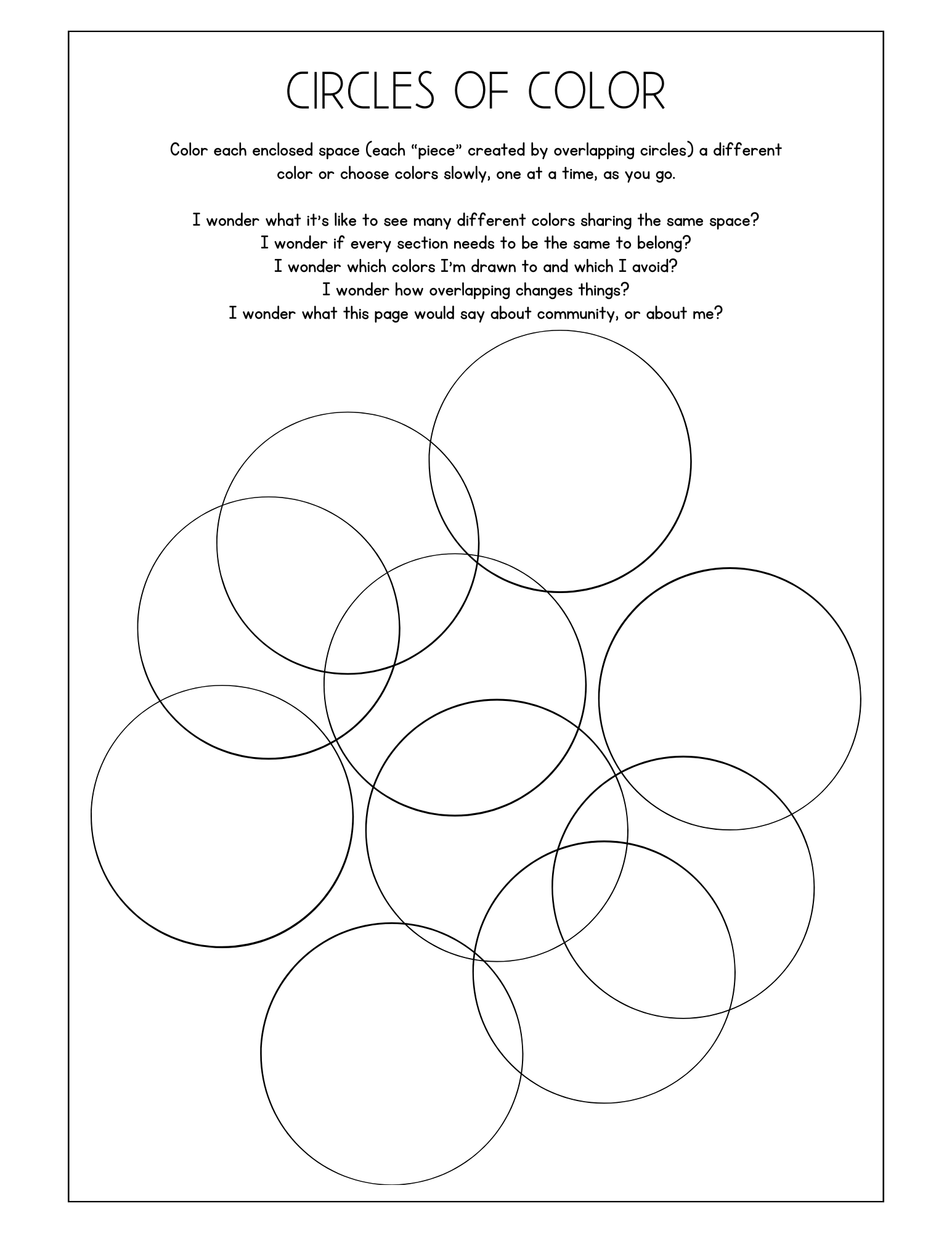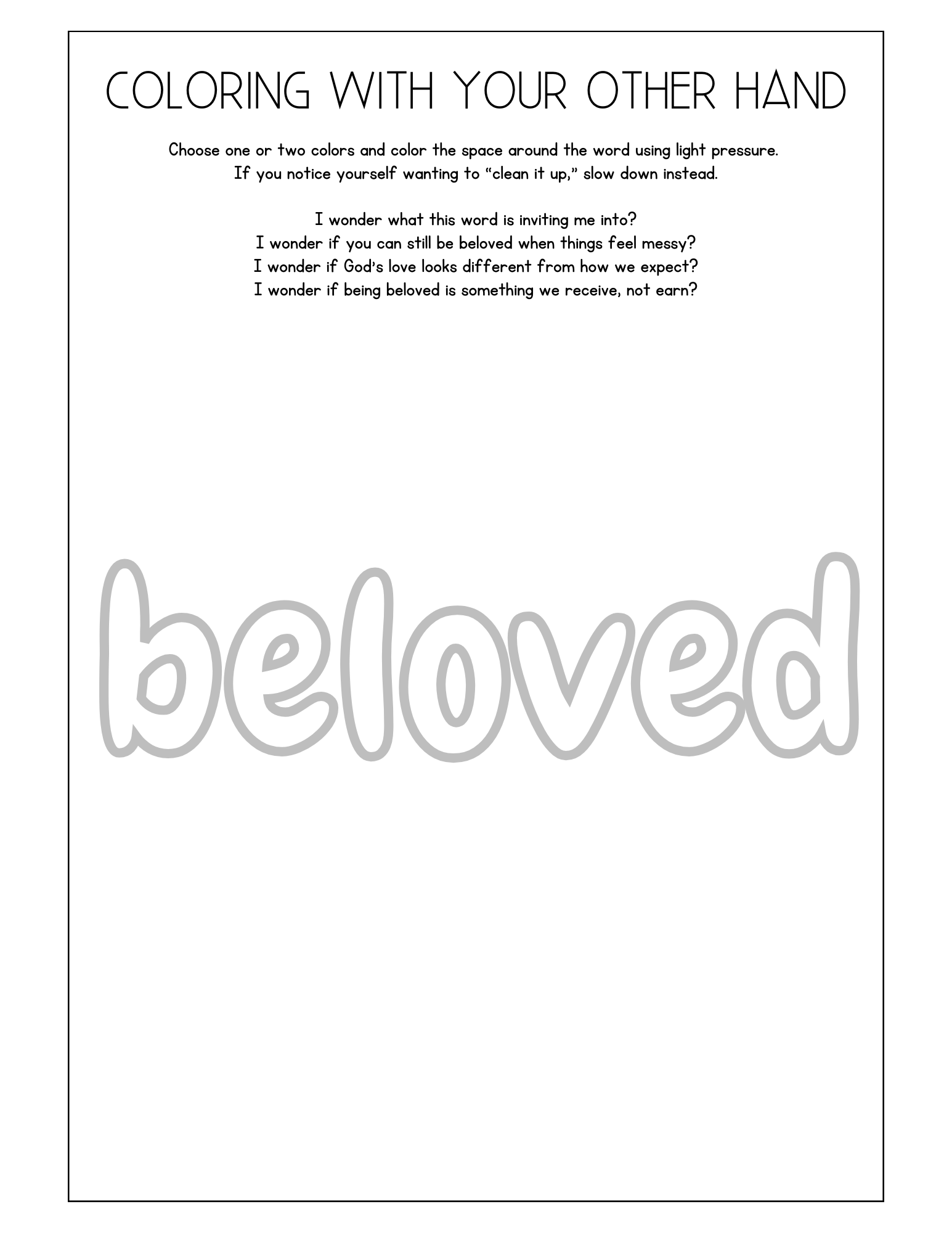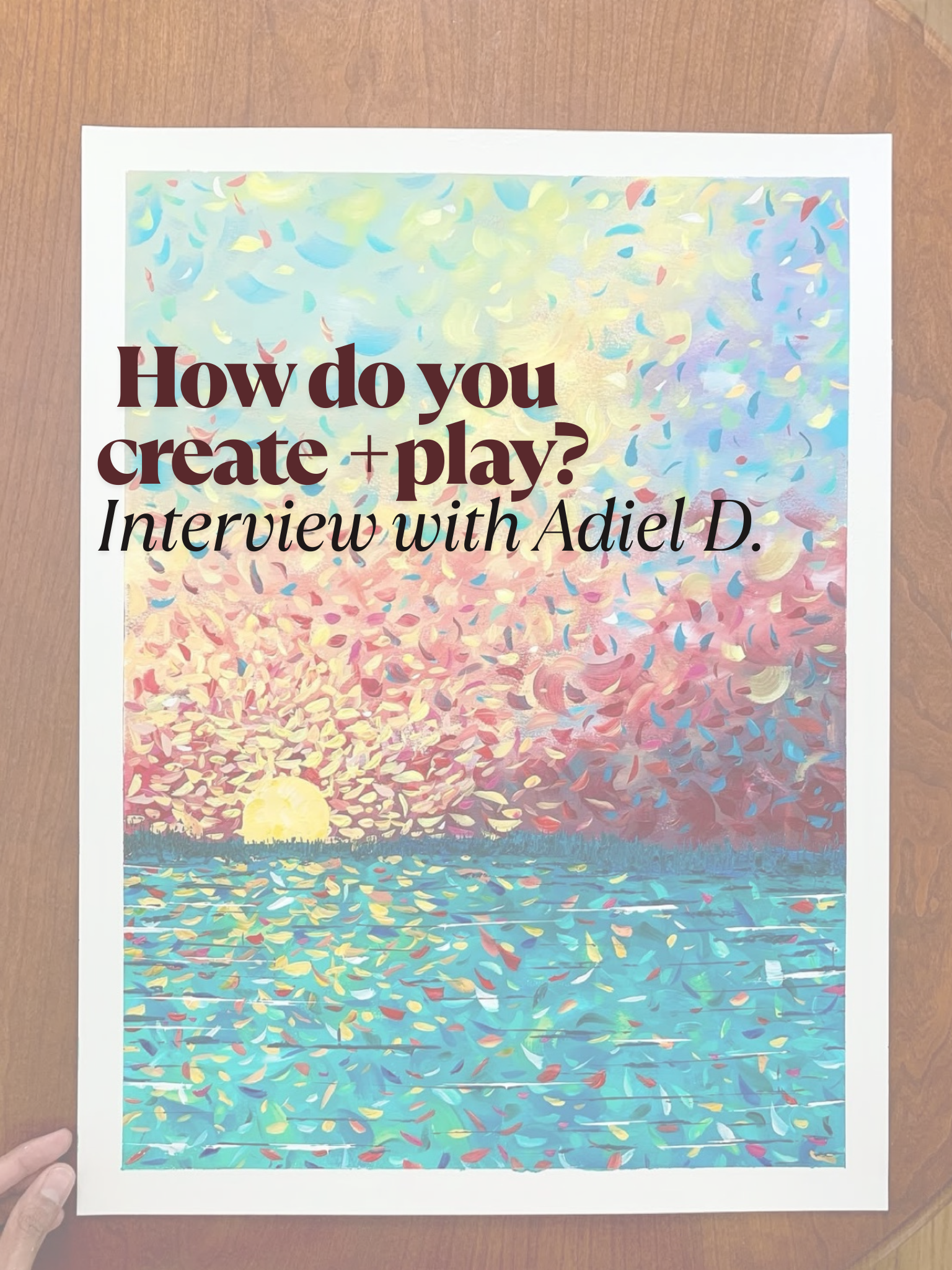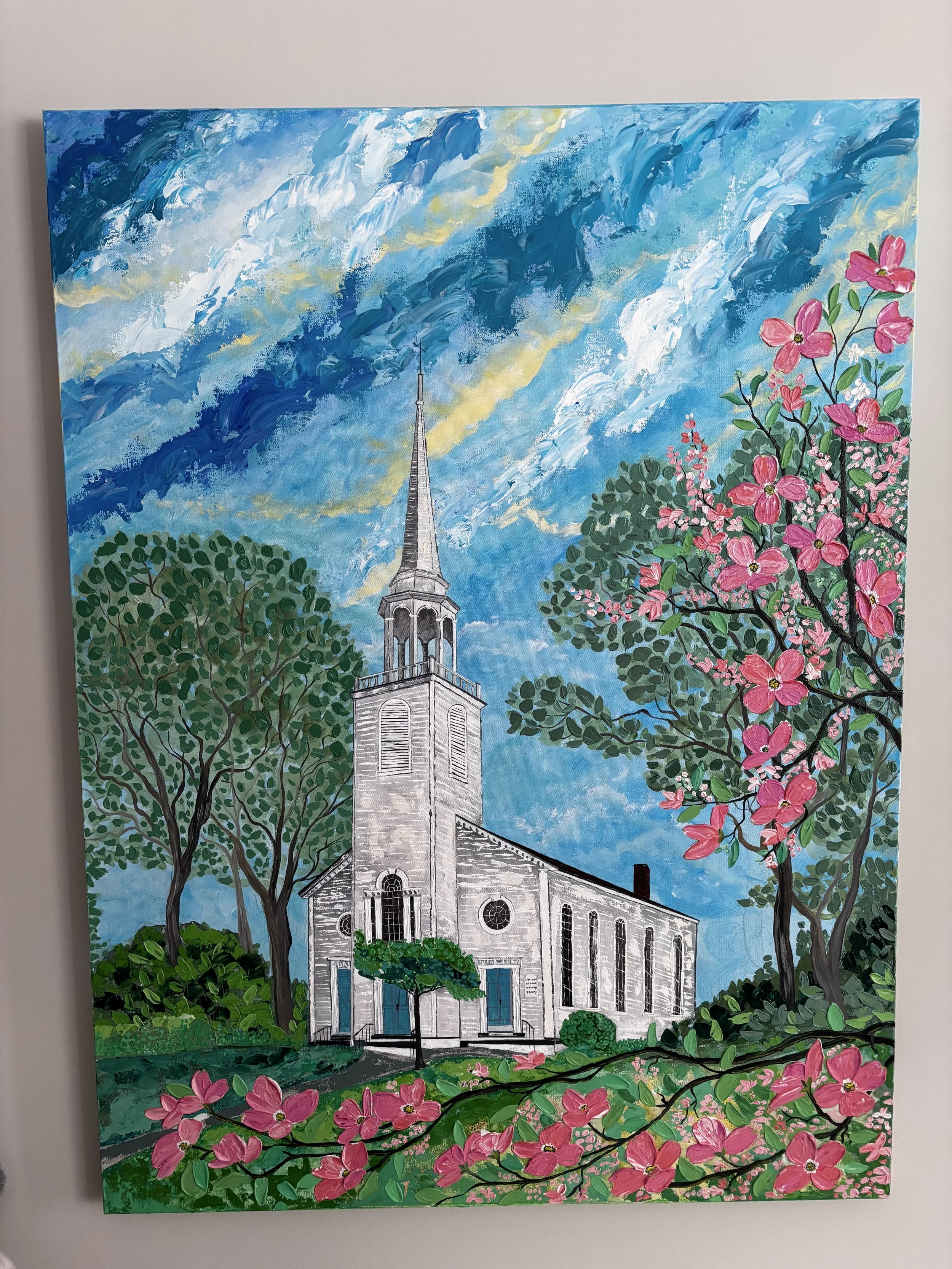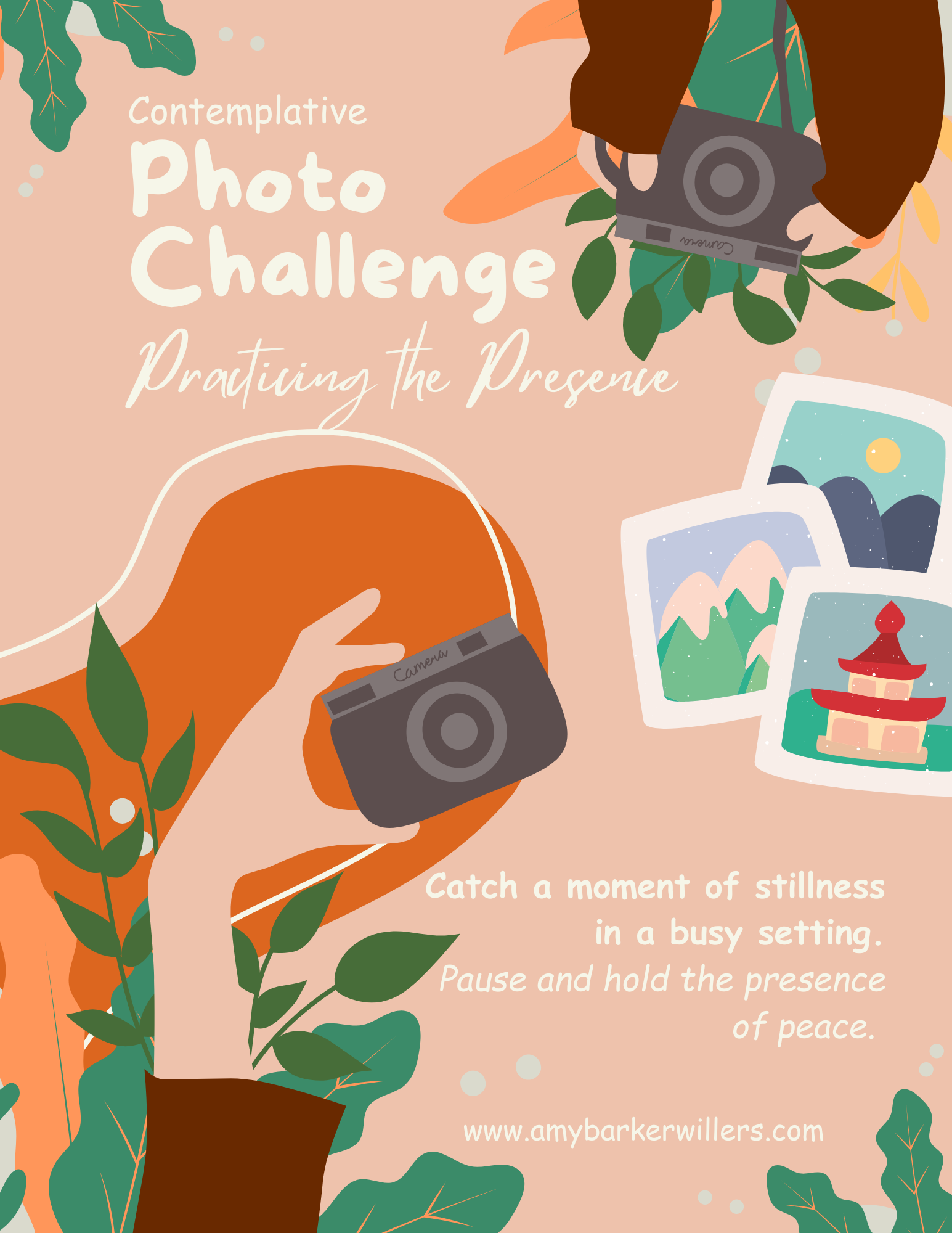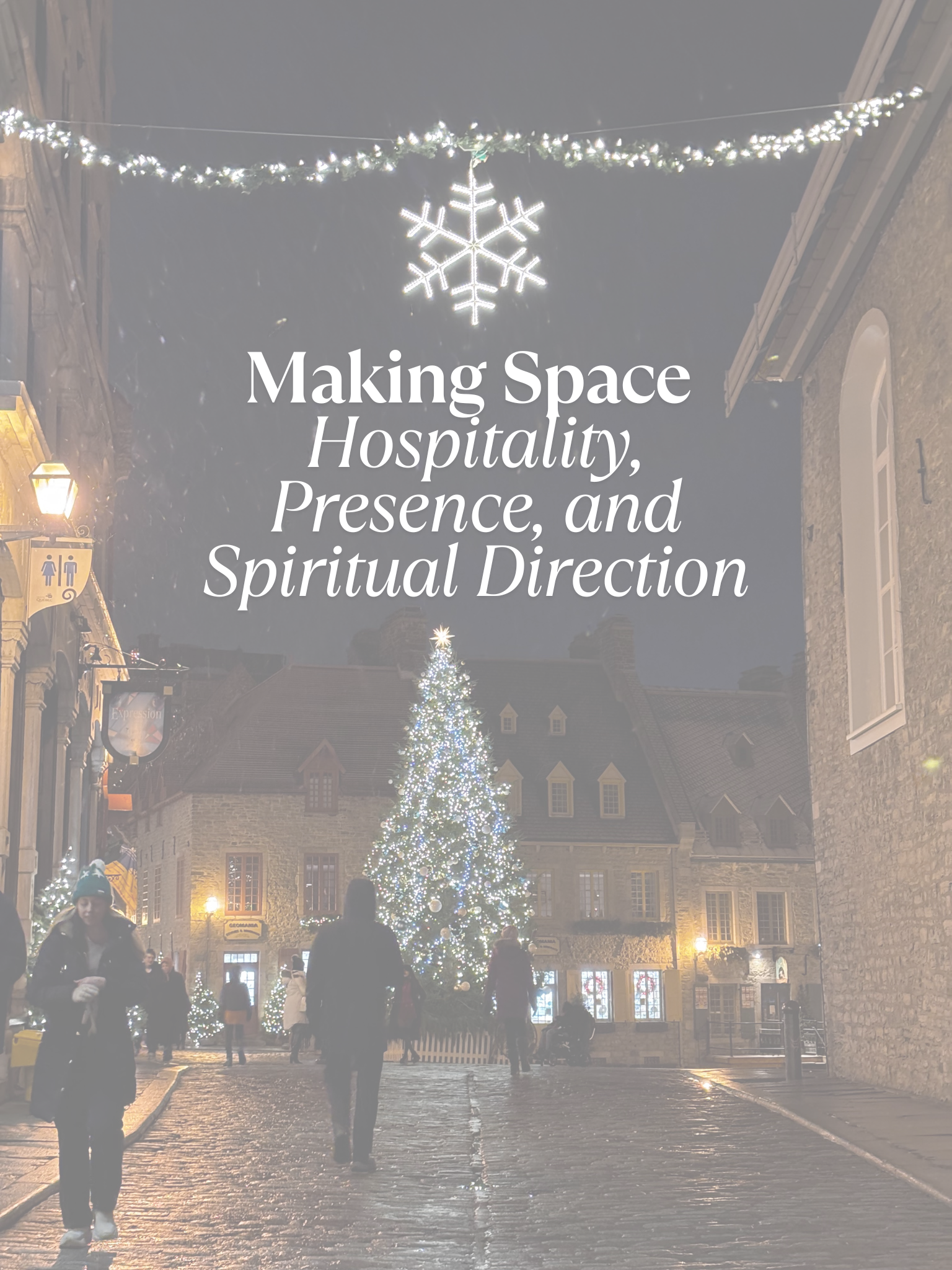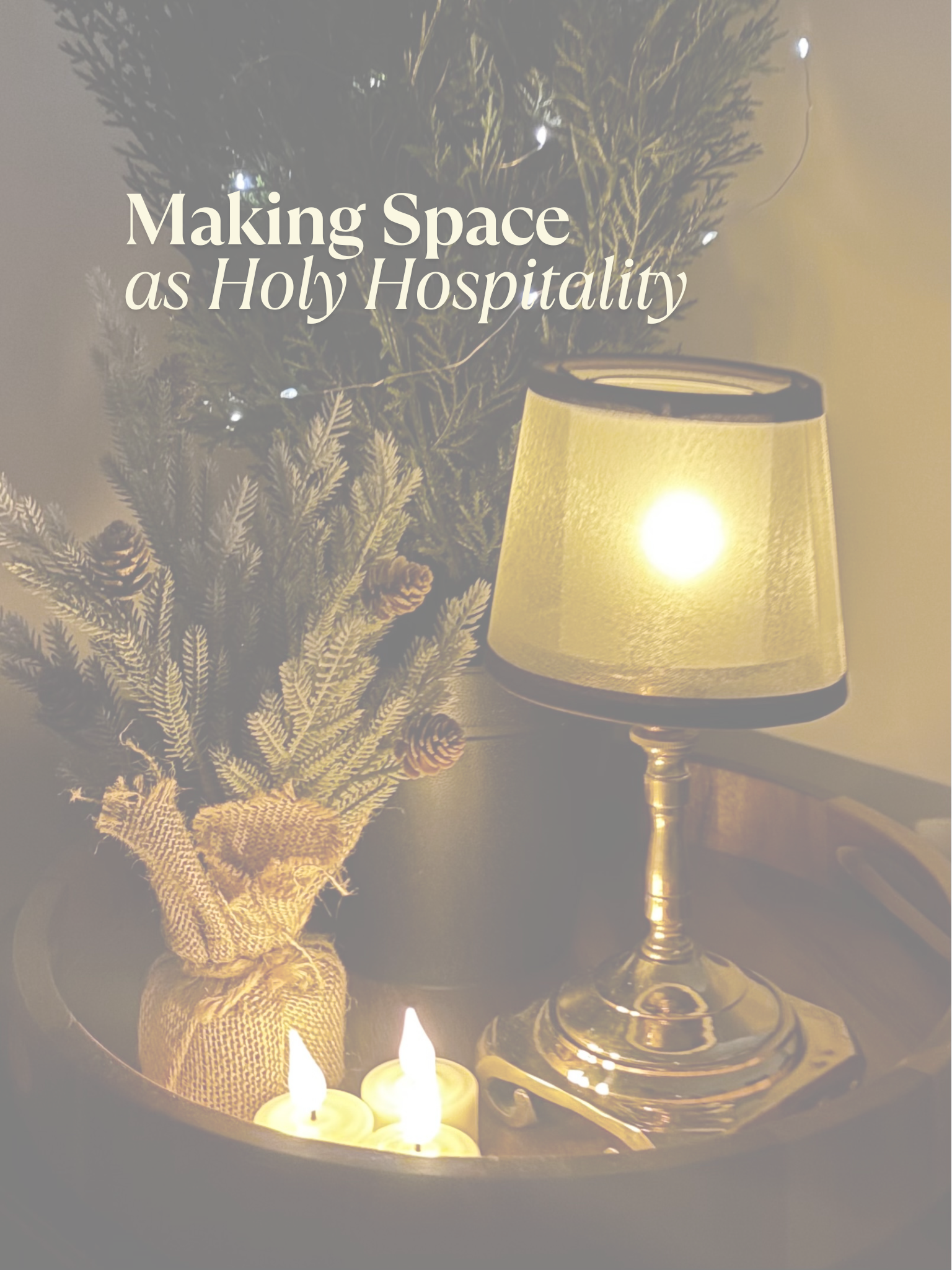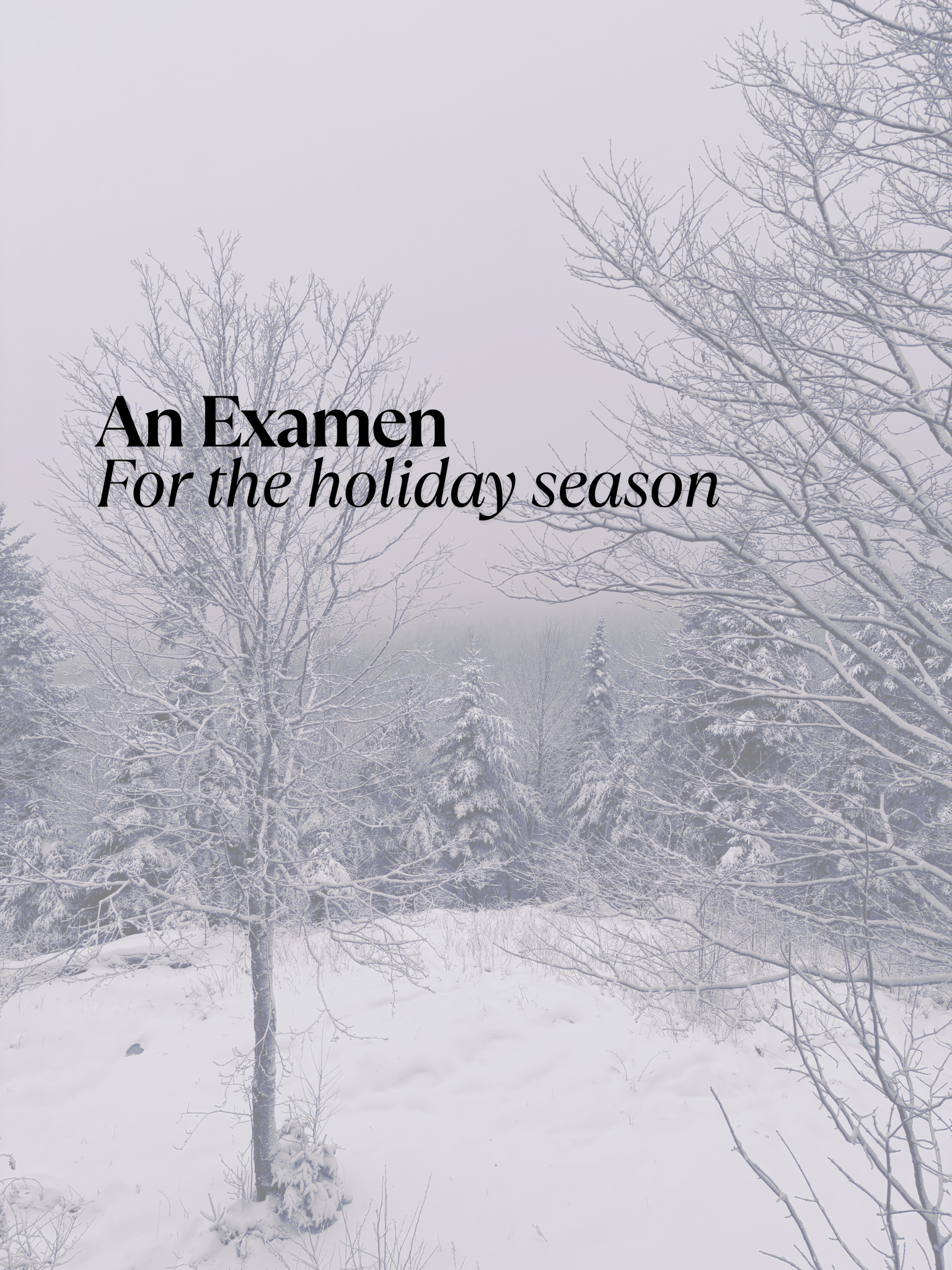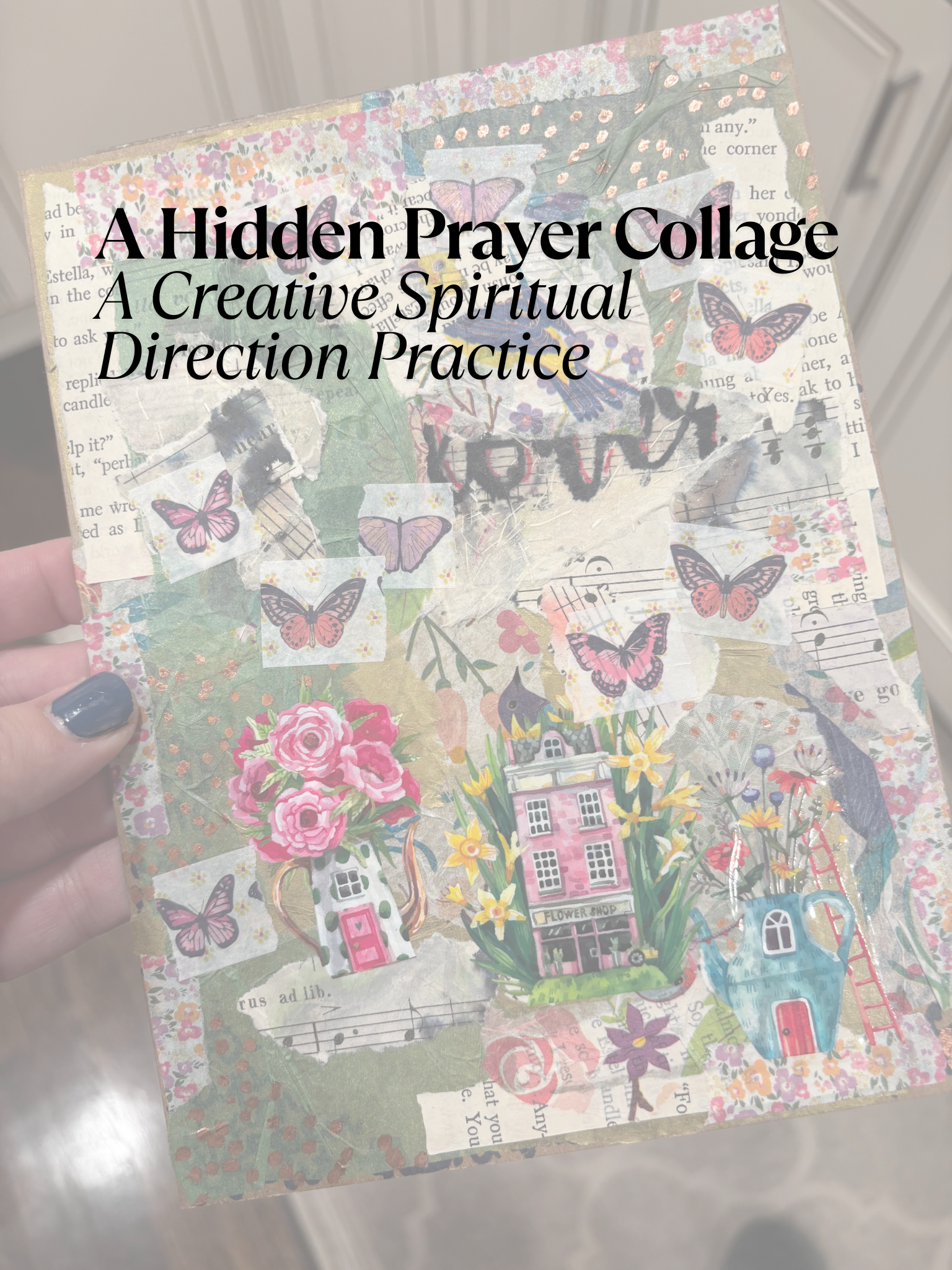Creative Prompt: Circles of Color
A practice in noticing difference, wholeness, and belonging
This week I wanted to paint circles. This is mostly because one of my favorite Instagram artists talks about how much she loves circles, and when she’s anxious, she paints circles. They are also easy and pretty. And surprisingly meaningful, with no sharp edges, no clear beginning or end.
Today’s practice invites you to work with circles in a very ordinary way, and to see what they might gently teach you.
On a blank page, trace a bunch of circles in different sizes. You can use cups, jar lids, tape rolls, or freehand them if you like. Let them overlap or crowd one another. Then, color each enclosed space (each “piece” created by overlapping circles) a different color or choose colors slowly, one at a time, as you go.
There’s no picture to make, just shapes and color.
Watercolor Option
This is particularly fun in watercolor because you can watch the colors blend together or watch what new colors they make when they overlap!
Lightly trace your circles in pencil.
Using watercolor, fill each section with a different color or shade.
Some can be bold.
Some can be pale.
You can let colors bleed where they meet (wet on wet), or keep them separate (wet on dry).
Notice how the page changes as it fills.
Pause when it feels complete, not when it feels perfect.
Colored Pencil or Crayon Option
Trace your circles with pencil or marker or use this coloring page.
Choose one color per section, or rotate through a small set of favorites.
You can:
press hard in some places
color lightly in others
leave some sections barely touched
Wondering Questions
You might hold one or two of these gently while you work, or reflect on them afterward.
I wonder what it’s like to see many different colors sharing the same space?
I wonder if every section needs to be the same to belong?
I wonder which colors I’m drawn to and which I avoid?
I wonder how overlapping changes things?
I wonder what this page would say about community, or about me?
A Kid-Friendly Version
Invite kids to:
Trace lots of circles: big ones, tiny ones, silly ones.
Color every little space a different color (or just their favorite colors).
You can wonder together:
Which circle is your favorite?
What happens when circles bump into each other?
How many colors can fit on one page?
There’s no wrong way to do this.
A Closing Invitation
This is a practice of many parts making one page and noticing how boundaries and overlaps both create beauty.
When you’re finished, take a moment to look at the whole page. What would it be like to trust that there is room for all of this?
If you feel comfortable, I’d love to see what you create. When I share these prompts, I’ll always try to share what I’ve made too. Tag me on Instagram or comment below with a photo or reflection.
Making Space might mean Releasing
It’s the beginning of the month, and we return again to the idea of making space. It sounds simple, even inviting, but it is rarely actually easy. Making space isn’t just about clearing our calendars or carving out a quiet moment. Sometimes it asks something more costly: to loosen our grip, to release expectations, to lay down ways of being that once felt necessary but no longer give us room to breathe. Before we can experience deeper intimacy with God, we may need His help to notice what we’re still holding and what He is inviting us to lay down.
I had a humorous experience in spiritual direction last month that brought this home for me. As I was reflecting on releasing expectations I carry for myself, I remembered a time when God was gently showing me I didn’t need to do something. I was deep into Christmas pageant planning when it occurred to me that I should make cute programs to hand out before the show. I immediately sensed that this was an extra task I didn’t need to take on, but I resisted and made them anyway. They took about two hours to design, print, and cut. Pageant day came and went, and I had completely forgotten about them. Not a single person saw one or took one home as a memento. When I remembered this, I laughed out loud.
It’s a funny example, but it revealed something deeper in me. Even though I’ve grown in many ways, I’m still sometimes trying to prove myself. In making those programs, I wanted people to see that I was capable. This is where it gets tricky, because they would have been a sweet extra for the day, a meaningful keepsake for the kids. I wasn’t wrong to want to make something beautiful. But this is where discernment matters, because God sometimes invites us to stop, not because the thing is wrong, but because it isn’t required.
The issue wasn’t the action; it was the attachment. Releasing is hard work. It often takes more than one gentle prompting from the Spirit.
Here are some common examples of what we might need to release in order to make space for God, for ourselves, and for others:
Releasing expectations we place on ourselves
Releasing real or imagined expectations others place on us that are unfair
Releasing control and the need to manage outcomes
Releasing urgency, the sense that everything is pressing and must be decided now
Releasing certainty by loosening our grip on having the right answer, the right words, or a neatly wrapped theology
Releasing comparison (this one hits deep)
Releasing noise, both internal and external
Releasing the belief that productivity equals worth, or that there is an “ideal version” of ourselves we could reach if we just tried harder
Releasing our hold on self-protection, lowering the guard just enough to be honest with God, with ourselves, and with trusted others; letting tenderness exist without immediately armoring it
As we begin this month, perhaps making space doesn’t require a dramatic shift or a perfectly named practice. Maybe it begins with noticing, not just what we’re doing, but how tightly we’re holding it. The invitation may not be to stop doing good or beautiful things, but to release the attachments that weigh them down. We don’t have to loosen our grip all at once. We can open our hands just a little, trusting that God is patient and kind, and that the space created, however small, is enough for Him to meet us there.
Sacred Story Time: Moments in Nature
I’ve been using Slow Down: 50 Mindful Moments in Nature by Rachel Williams as a kind of devotional. It’s written for children, but the invitation to slow down alongside the natural world was too good to pass up. Each spread highlights a simple truth: so much of life in nature happens slowly. Seeds wait underground. Animals pause to listen. Trees grow ring by ring, year by year.
As I read, I find myself moving at the book’s pace, lingering over illustrations and marveling at God’s good creation. With every page, I ask myself a quiet question: What is God inviting me to notice here? Not notice in a hurry or over-analyze, but notice in the way children do, with curiosity and care.
This book offers a beautiful on-ramp into sacred story time, whether you’re reading with kids, using it in a classroom or church setting, or sitting alone with a cup of tea. Below are a few playful, open-ended prompts to help turn story time with this book into a sacred practice.
Noticing prompt:
As you read a page, pause and look closely at the illustration. What small details do you notice first? What do you notice second, once you’ve slowed down a bit more?
I wonder: What in my own life is growing quietly, slowly, without much attention right now?
Play prompt:
After reading, step outside or look out a window and choose one small part of nature to observe for one full minute. A leaf. An ant. The clouds. A patch of grass.
Set a timer if that helps. See how still you can be. See what moves when you don’t.
Imaginative prompt:
Imagine you are part of the scene in the book: a tree, a bird, a stream, or a seed beneath the soil.
What would it feel like to live at that pace?
What would you want to say to God from that place?
Prayer:
Generous God, thank you for creating this world for us to nurture, enjoy, study, and learn from. Help me to see you here, even in this tiny part of your beautiful world. Give me eyes to see even as I put this book down, so that I might continue to notice your peaceful nature in every creature. Amen.
A Simple End-of-Year Examen
A few years ago, I participated in an end-of-year online retreat that was essentially an examen, a guided time to look back over the year with God. We were invited to notice where the year held joy and grief, where we felt God’s presence, where we felt His absence, and then to gently turn our attention toward the year ahead by naming our hopes.
It was a simple, two-hour retreat, hosted by Tamara Murphy. And yet, I have never forgotten it.
I remember being genuinely surprised by what the Lord brought to mind during that time. Moments I might have dismissed as small rose up with meaning. Threads I hadn’t noticed before became visible. God felt near, not because the year had been easy, but because I was finally slowing down enough to see.
I don’t usually make New Year’s resolutions. I resist the idea that one day is more important than another, or that change must wait until January 1 (or the start of a month, or a Monday!). That belief runs deep in our culture and honestly, I still fall for it sometimes.
But I want to keep practicing this truth:
Every day is sacred. Every day is a chance to begin again.
In that sense, an examen doesn’t belong only at the end of the year. I can do a short examen each evening, looking back over the day, noticing where I felt God’s presence or resistance, gratitude or sorrow. This daily practice reminds me that God is already here, already at work.
And still… there is something uniquely powerful about doing an examen over a longer stretch of time.
Looking back over months instead of moments helps us notice patterns. It gives us space to reflect on what lingered, what surprised us, what kept returning. It allows gratitude to deepen and naming to become more honest. Often, it shows us that God was present in places we didn’t recognize at the time.
While a year-end examen can be done at any natural boundary, a school year, an anniversary, a season of life, the end of the calendar year often offers a gentle and natural pause to look back and look ahead, held together by prayer.
A Simple Year-End Examen
You don’t need a lot of time or special words. Just a willingness to be honest and attentive, and to trust that God meets us there.
1. Become aware of God’s presence.
Begin by settling in. Take a few slow breaths. Ask the Holy Spirit to guide your remembering, to bring to mind what God wants you to notice, not just what feels loud or obvious. Rest in the truth that God is already with you.
2. Review the year with gratitude.
Slowly walk back through the year. You might move month by month, season by season, or simply notice what rises to the surface.
Where did you experience joy, delight, or connection?
Where did you feel God’s nearness in moments of grief, loss, or lament?
Even if the year felt heavy, ask gently: What gifts were present, even here?
3. Notice moments of absence or resistance.
Where did God feel distant? Where did you feel numb, rushed, or closed off? This isn’t about blame, it’s about honesty. God can meet us even in what feels unresolved.
4. Watch for patterns.
As you reflect, notice what repeats. Is there a theme that emerges, a longing, a fear, an invitation, a place of growth or fatigue? Choose one pattern and bring it to prayer. Ask God what He might be showing you through it.
5. Look toward the year ahead.
Finally, turn your gaze forward. What hopes do you carry into the coming year? What do you desire, not just to do, but to receive? Hold these hopes lightly before God, trusting that the One who was faithful in the past will meet you again in what’s to come.
An examen doesn’t give us tidy answers. But it does give us something better: awareness, gratitude, honesty, and hope. It helps us remember that God has been with us all along and that He is already waiting for us in the days ahead.
Fostering Spaces of Wonder
I’ve been thinking a lot about wonder lately and how to foster it in every day spaces. As I’ve been holding these questions during Christmas, I found myself returning again and again to Mary. And only just now did I realize: Mary shows us how to foster spaces of wonder.
When Scripture tells us that Mary “pondered these things in her heart,” it’s describing exactly what I mean by wonder. She doesn’t rush to explain or resolve what’s happening. She makes room. She holds the mystery gently. She takes a quiet step of trust without demanding clarity.
To foster spaces of wonder is simply this: to make room.
This is what I mean when I talk about contemplative play. Yes, it includes time to create, imagine, and play but it goes a step further. It invites us into wonder by slowing down enough to notice what’s stirring within us, by asking gentle questions, by imagining what God might be inviting us into beneath the surface.
Contemplative play is not about producing something meaningful; it’s about being present to what is already unfolding. It’s choosing attentiveness over efficiency, curiosity over certainty. In that way, it becomes a spiritual practice, one Mary models so beautifully for us.
I suspect I’ll keep returning to this theme in the coming months, because I’m increasingly convinced that wonder itself is a spiritual discipline, one that our modern day faith desperately needs. But for now, I want to leave you with a few simple ways to begin fostering these kinds of spaces in ordinary, everyday life.
Simple ways to foster wonder in everyday life
Slow the pace. Leave margin in your day to linger, notice, and pause instead of rushing to the next thing.
Practice not-knowing. Replace quick answers with wondering questions: What do I notice? What surprises me?
Lower the stakes. Engage in activities that can’t be done “right”, like free drawing, playful movement, and contemplative or imaginative prayer.
Use your senses. Light a candle, touch natural materials, listen closely, breathe deeply.
Welcome silence. Even brief moments of quiet create space for God to speak beyond words.
Pay attention to small beauty. A patch of light, a child’s question, a line of poetry, a moment of peace.
Model curiosity. Say your own wonder aloud, about God, Scripture, people, and the world. Even better, be curious together in a group.
Like Mary, we may not always understand what God is doing. But when we make space to ponder, to wonder, to stay open, we create room for faith to grow.
What Is God Inviting Me to Notice?
During my training in spiritual direction, we practiced a lot of directing. Often it looked very simple: meeting in groups of two or three for as little as five minutes. One person would share, one would listen as the director, and sometimes a third would simply hold the space.
We were given a simple instruction each time: share something real, even if it’s small.
Over the course of the two-year program, I probably participated in an exercise like this twenty times or more. And every single time, God showed up.
Nothing flashy was happening. We were just practicing listening to one another and to God. But it was real. Consistently, unmistakably real.
That may be the biggest thing I took away from my training: with even a small amount of intentionality, we can meet with God. Not because we are especially skilled or holy, but because God is already there, waiting for us, pursuing us, and loving us.
This is why I talk so much about contemplative play.
When we make space for rest and play, and then take one small step further by bringing intention into it, we create room to hear from God. These practices don’t have to be heavy or complicated. They can be gentle, playful, and embodied. Sometimes they are easier with others, which is why I believe so deeply in spiritual direction and shared practices of noticing. But they can also be woven into ordinary moments of daily life.
This is also why I’ve shifted the way I do book reviews and now call them Sacred Story Time.
For years, I reviewed children’s books because I wanted to help adults and children learn to see Jesus in their everyday lives, in their work, their play, and their rest. Children’s books are a surprisingly accessible doorway into that kind of noticing, even when the books themselves aren’t explicitly Christian. Stories train our attention. They soften us. They help us practice seeing meaning, beauty, and presence everywhere.
Going forward, my book reviews will always include playful, contemplative prompts. I may even revisit some reviews from the past through this lens. But you don’t need a specific book, or even a book at all, to begin.
You can start right where you are. With the story you’re reading. The game you’re playing. The moment you’re living.
Simply ask:
What is God inviting me to notice here?
God is trustworthy. Attention does not change God; it changes us. As we practice noticing through story, play, and rest, we are formed to recognize the grace that was already there.
Creative Prompt: Write One Word with Your Non-Dominant Hand
A practice for loosening perfectionism and making space for wonder
Most of us were taught, early on, how to hold a pencil correctly, write neatly, and color inside the lines. Over time, that training can quietly turn into something heavier: the belief that our work, and sometimes we ourselves, need to look a certain way to be acceptable.
Today’s creative practice invites us to lay that down, just for a few minutes.
Instead of striving for beauty or clarity, we’ll practice receiving.
Instead of control, we’ll practice attention.
Instead of perfection, we’ll practice wonder.
Choose a single, gentle word. Something simple. Something kind.
Some ideas:
rest
light
here
beloved
enough
peace
home
Using your non-dominant hand, write that word slowly on the page, letting it be imperfect. Resist the urge to fix it! When the word is written, add color around the word, not inside it. Let the word remain as it is.
Watercolor Option
Lightly write your chosen word with your non-dominant hand using pencil or pen.
Take watercolor and add soft washes around the letters.
You can let color pool near some letters and fade away from others.
You can use one color or many.
Let the paint respond to the word rather than illustrate it.
When you’re finished, pause before adding anything else. Notice what’s already there.
This is not about making the word pretty; it’s about letting it be.
Colored Pencil or Crayon Option
Write the word with your non-dominant hand, or use this coloring page and the word “beloved”.
Choose one or two colors.
Color the space around the word using light pressure.
If you notice yourself wanting to “clean it up,” slow down instead.
The uneven lines and imperfect letters are part of the practice.
Wondering Questions
You might hold one or two of these gently as you work or return to them afterward.
I wonder how it feels to write without trying to get it right?
I wonder what this word needs from me today?
I wonder if this word feels different when it’s imperfect?
I wonder what happens when I don’t correct myself?
There are no right answers. Let the questions stay open.
A Kid-Friendly Version
Invite kids to:
Pick a word they like (or help them choose one).
Write it with their “other hand” or let them guide your non-dominant hand as you write.
Color around it any way they want.
You can wonder together:
What do you notice about your letters?
Was it hard or funny to use your other hand?
What does this word make you think of?
Celebrate the wobbliness. Laugh if it feels silly. This is part of the gift.
Why This Practice Matters
Using our non-dominant hand interrupts our habits of control and slows us down. It quiets the inner critic that says, This should look better than it does. In that interruption, something else becomes possible.
Wonder. Gentleness. A posture of receiving rather than proving.
Like entering the kingdom as a child, not because we’ve mastered something, but because we’re willing to be small, open, and attentive.
A Closing Invitation
You might place your finished page somewhere you’ll see it later. Not as a reminder of what you should do, but as a witness to what happens when you let go. Sometimes the most faithful thing we can do is stop trying to make things right and simply allow ourselves to be here.
If you feel comfortable, I’d love to see what you create. When I share these prompts, I’ll always try to share what I’ve made too. Tag me on Instagram or comment below with a photo or reflection.
Showing Up Without Knowing: A Spiritual Discipline of Wonder
I keep asking the same question: how do you create and play?
This is not a soft question or one I just ask for fun. I ask it because I want us all to foster spaces of creating and playing. These habits shift our posture from certainty to wonder and help us approach God that way, too.
Wonder is not the absence of faith; it is a way of practicing it. It loosens our grip on mastery and polish, releases the need to be right, and allows us to stay open to God, to ourselves, and to what is still becoming.
Practices like creating, playing, and simply being with God in silence are profoundly formative. They teach us to come with curiosity instead of control, to listen more than we explain, and to trust that God meets us not only in clarity but also in beginnings, questions, and unfinished places.
Jesus pointed to a childlike posture not because children understand more, but because they receive more. They enter without needing certainty first. They engage before they comprehend.
Yesterday, in my spiritual direction group, we spent a long time in silence (a gift in itself) before I shared. They listened, cried, and prayed with me. When we ran out of time, I felt a pang of panic: I was the only one who got to share, and I wanted to repay them somehow. But they gently reminded me that perhaps God was inviting me to simply receive that day, from Him and from a safe, trustworthy group of friends.
Wonder restores that posture toward God in us. Intellectual knowledge and theology certainly have their place. I am deeply grateful for my years of studying Scripture through Christian education; I don’t think I would discern God’s voice as I do without it. Yet we are often tempted to approach God with certainty because of all our knowledge: answers already formed, conclusions already drawn, or outcomes already imagined. Certainty feels faithful. It feels responsible. But certainty can quietly turn into control, and control leaves very little room for God to move.
Wonder creates room.
As a spiritual discipline, wonder looks like creating without knowing the outcome, praying without demanding answers, and trusting God enough to remain open. It is choosing presence over polish, receptivity over mastery, and faith over control.
In a world that rewards certainty, wonder becomes a quiet act of trust, and practices like creating and playing help us cultivate it, shaping our hearts to stay open and receptive to God in all moments.
How do you create + play? Interview with Adiel
So often, we think of creativity as something we produce, like a finished piece, a result, or something to show. But what if creativity is just as much about how we pay attention? How we notice beauty, feel freedom, and make space to be fully present?
In this interview, I spoke with an artist whose painting practice began as a way to express himself and has grown into something much deeper. Through paint, texture, color, and even the joyful interruptions of his children, he has found a rhythm of creating that holds peace, connection, and faith, sometimes without many words at all.
His reflections are a reminder that creating doesn’t have to be perfect or polished to be meaningful. It can be messy, embodied, shared, and holy in the quietest ways. This conversation is an invitation to linger, to notice, and to trust that simply showing up to create is enough.
What first drew you to painting and what keeps you coming back to it now?
It’s hard to say just one thing that draws me to painting. I started painting, as far as I can remember, when I was 10 years old. At first, it was the need to express myself in a different way. As I grew older, I began noticing simple but beautiful things. Painting is like an outlet for me to feel freedom and peace; it helps me highlight the beauty I find in the simple things around me.
What happens in you when you’re painting? What do you notice, feel, or pay attention to?
When I paint, my mind just flies. I feel light, and I can clearly see the picture my hands are creating, even though it’s not finished. The colors I use, the textures, the smell in my studio, and the giggles of my daughters—who often distract me—are all part of the process. Those moments are good, because I come back with fresh ideas.
You sometimes paint with your little girls. What do you think happens when people create things side by side?
I think this is one of my favorite things to do as an artist: sharing my tools and knowledge with little ones. Art is so important for young people. Creating with my daughters is chaotic and, at the same time, beautiful. They see things that I don’t see, mix colors that make no sense, and draw things that feel out of this world. When we are creating, we are together not only physically but also spiritually—if that makes sense. We don’t talk much; we just get lost in the midst of colors, splashes of paint, and more.
Has painting ever helped you slow down, notice beauty, or connect with something bigger than yourself?
As an artist, sometimes it’s hard to slow down—we are always thinking about the next project and what else we can paint or build. Painting does help you slow down when you allow it to. I use the time when I’m alone in my studio to connect with my faith and talk to God about how He wants me to use my talents. I ask for guidance, or sometimes I simply thank Him.
If you can imagine Jesus sitting beside you while you paint, what do you think he is doing/saying/thinking?
This is a beautiful picture. After I finished reading this question, I immediately pictured this scene: God beside me, looking at me with loving eyes, observing—not saying anything, just being—and that is enough for me.
What would you say to someone who wishes they could create like that, but doesn’t know where to start?
Art is not perfect—it’s messy, and most importantly, it’s for you. It’s about how it makes you feel. So if you have the thought or curiosity to draw, paint, or simply create something, please go for it. I started painting with charcoal because it was inexpensive and all my parents could afford. Hopefully this motivates you to create and inspire others.
Thank you again, Adiel, for sharing your painting and wisdom with us!
I am hoping to continue with this series and send each person off with a blessing of their hobby. So Adiel, here is my prayer for you:
Creative and beautiful God, thank you for planting your creativity in us, so that when we create we can feel closer to you and your delight in us. Bless the holy work of painting for Adiel. Help him to continually feel your pleasure as he joins you in creating beauty. Thank you for his eyes that see beauty in the world, and the way he helps us see it, too. Bless the time he spends painting with his daughters, and may it instill in them a love of you, as they feel your delight, too. And may your love and peace surround Adiel and his family with every brushstroke of paint.
Practicing the Presence | Prompt 7: Stillness in a Busy Place
“Catch a moment of stillness in a busy setting. Pause and hold the presence of peace.”
Most of us assume that stillness only happens when everything else stops. But real life doesn’t usually work that way.
More often, our days are full of voices, movement, responsibility, and pressure. And yet, even there, moments of stillness appear if we’re willing to notice them.
Stillness doesn’t always mean silence. Sometimes it means presence.
What Is “Practicing the Presence”?
Practicing the presence means paying attention to where God already is rather than waiting for ideal conditions. It’s learning to notice God in the middle of ordinary life, even when things feel busy or unsettled. Especially then.
Peace, in this sense, isn’t something we manufacture. It’s something we recognize.
Try This
Today, notice a moment of stillness in the middle of a busy place. It might be brief. It might feel almost insignificant. That’s okay.
When you find it, pause. Take one slow breath. Let yourself be there without fixing, solving, or rushing on.
If you’d like, take a photo, not to capture perfection, but to help you remember that peace can exist alongside movement and noise.
You might ask yourself:
Where did I notice stillness today?
What did it feel like in my body?
How might God be meeting me in this moment?
You don’t have to escape your life to find God’s presence. Sometimes, all that’s needed is a pause right in the middle of it.
Making Space: Hospitality, Presence, and Spiritual Direction
Hospitality in Scripture is fundamentally about making space: in our homes, around our tables, in our hearts, our schedules, and our communities. We see this again and again in the Bible. Abraham welcomes strangers with open hands and an open tent. Martha opens her home to Jesus. And Jesus Himself invites the weary and burdened to come and rest.
Hospitality, at its core, is not about impressing or performing. It is about presence.
When we have space, both inner and outer, we are actually more available to love. But when we are hurried, stressed, or overscheduled, we tend to miss the needs around us. Not because we don’t care, but because we are stretched too thin. Our attention is divided. Our energy is spent. Our hearts are crowded.
This is where margin matters.
Margin creates capacity. Capacity to notice, pause, respond, and be present.
Jesus modeled this way of living. He regularly stepped away to pray, to rest, to be alone with the Father. Those quiet spaces were not a retreat from love, but the very thing that made love possible. Because He made space, Jesus could move with compassion when the crowds showed up, when someone tugged at His robe, when a friend needed healing.
This is also the heart of spiritual direction.
Spiritual direction is not about fixing your life or adding more spiritual tasks to your to-do list. It is a practice of making space to notice where God is already present and at work, space to listen to your own life with gentleness, space to tend your relationship with God without hurry or pressure.
In spiritual direction, you are received just as you are. Your questions, longings, exhaustion, and hopes are all welcome. Together, we create a small pocket of holy space where your heart can stay soft, attentive, and open to love.
So making space is really an act of hospitality. Not in a productivity sense (You must clear your schedule so you can do more!) but in a deeply spiritual sense: I make space in my life so love has somewhere to land.
It’s not the only expression of hospitality, but it is a real and important one, especially in a world where so many of us are overwhelmed and overcommitted. And sometimes, making space is something we don’t have to do alone.
Making Space as Holy Hospitality
So often, when we talk about “hospitality,” we imagine setting a table, opening our homes, or planning something special. But lately I’ve been wondering if the deepest form of hospitality starts long before any of that, long before a meal is cooked or an invitation is sent.
Maybe the truest hospitality begins with making space.
Because the truth is: most of us are doing so many things we don’t actually need to be doing. We rush from one commitment to the next, carrying invisible to-do lists in our minds, tending tasks that no one asked us to carry. And without realizing it, we end up with lives so full that there’s no room left for God, for others, or even for our own souls.
But when we gently begin to release what is unnecessary something beautiful happens. We discover that making space is hospitality.
It is the quiet, intentional choice to create room for God to speak, room for rest to restore us, room for someone else’s need to enter our life without knocking everything over.
When we have margin, we can actually respond to others with joy instead of resentment. We can pause and listen instead of rushing past. We can notice the child who seems “off” today. We can bring a meal, offer a ride, pray with a friend, or sit with someone who is grieving. We can say “yes” at the moments when our “yes” might genuinely make a difference.
And maybe this is what Jesus meant when He said, “Come to Me… and I will give you rest.” His invitation is not to do more, but to open more space to receive His rest so we can extend it to others.
Making space is not laziness. It’s not quitting. It’s not neglect. Making space can be holy hospitality, an act of love that begins with making space for God in the heart and spills out into the world.
So as you move through this week, maybe wonder:
What is one small thing I can release?
Where might God be inviting me to make room?
How could this little bit of margin become a gift for someone else?
And when you do make space, trust that God will fill it with His presence and His purposes. Always.
Creative Prompt: Paint a Candle
There’s something powerful about painting around the light instead of painting the light itself. This simple practice helps you remember that some things are best shown by making space: rest, presence, God’s nearness, hope.
Today, you’ll paint a candle but the flame stays unpainted. Let the blank space shine.
Step-by-Step (Watercolor)
Start with a light sketch of a candle: a simple rectangle for the candle and a small teardrop shape for the flame.
Do not paint the flame. Leave it completely white, untouched paper.
Paint the candle body in soft, warm colors. Let the paint be loose, imperfect, maybe dripping a little like wax.
Around the flame, add gentle washes of color that grow lighter and lighter as they reach toward the flame.
Imagine the flame pushing the color outward.
Let the white space do the work.
Add optional details once the paint dries (a wick, shadows, edges) or leave it simple and quiet.
This practice becomes a reminder that the most luminous things in our lives often come from the spaces we keep open.
Colored Pencil/Crayon Option
Draw a candle and flame, leaving the flame uncolored, or use this coloring page.
Color the candle in your favorite warm tones.
Around the flame, press lightly with your pencil or crayon.
The closer you get to the flame, the lighter your pressure.
The farther away, the deeper and richer the color.
If you want, outline the flame very gently with a soft yellow pencil, but keep the inside white.
Even with crayons, the uncolored flame becomes the brightest part of the page.
Wondering Questions
I wonder what the unpainted flame makes you think of?
I wonder if there is a space of light in your life right now?
I wonder what the blank space invites you to notice or remember?
I wonder how it feels to not fill something in?
Kid-Friendly Version
Draw or paint a candle: tall, short, silly, colorful, whatever you want but don’t color the flame.
Leave it white, as if the paper itself is glowing.
Then ask:
What do you think the light is for?
What makes you feel bright inside?
Who brings light into your world?
You can even draw little things around the candle that your light helps or warms, like tiny creatures, stars, or cozy objects.
Closing Thought
Leaving the flame unpainted becomes its own kind of prayer, an open space for God to shine, a reminder that not all light is ours to create.
Sometimes the most sacred thing we can do is simply make room for it.
If you feel comfortable, I’d love to see what you create. When I share these prompts, I’ll always try to share what I’ve made too. Tag me on Instagram or comment below with a photo or reflection.
Small Ways I’m Making Space Right Now
I’ve been struggling to make space this month. Ironically, even to write about making space. So I finally decided to take my own advice and remember that creating room for God and my own well-being doesn’t have to be big or impressive; it just has to be a priority. Here are a few small, grounding ways I’ve been practicing “making space” in this very full season:
• Daily coloring pages. I committed to coloring one tiny page a day. It takes only a few minutes, but it feels fun, soothing, and doable. I use just one or two colors to keep it simple, and I don’t worry about staying in the lines. It’s a pocket of creativity I actually look forward to.
• Spiritual direction. I made an appointment with my spiritual director. Spiritual direction offers so many gifts (which I know I’ve talked about before!), but one of the biggest is the simple commitment of showing up for someone else. I’m far more likely to honor a space I’ve set aside with another person than one I promise only to myself.
• Going to the gym. I’m an incredibly inward person with a rich inner world, so tending to my body has never come naturally. But we are embodied people, and moving my body matters. I recently joined a gym so I could bring my daughter a few times a week. Even when I don’t feel like going, I still go for her; and it turns out it clears my mind and gives me energy, too.
• Baking bread. This one is new for me. After a year and a half of trying to get a sourdough starter going, I finally have a thriving one… and now I’m a little obsessed. Sourdough forces me to slow down. Each loaf takes about 24 hours, and I’m making around three a week. With every stretch and fold, I find myself praying for whoever will eat that loaf (I give many of them away). It feels beautifully countercultural to move at the pace of fermentation. Maybe that’s why sourdough has become so popular: we’re hungry for slowness and we long for spaciousness. Sourdough demands both.
If you’re finding it hard to make space right now, space for God, for rest, for listening, I’d be honored to come alongside you. Spiritual direction can offer a gentle, structured place to breathe and pay attention. If you need help creating that space, you can always make an appointment with me.
An Examen for the Holiday Season
Take a deep breath. Let your body be still.
Notice the way your breath settles you, drawing you into the present moment.
What gratitudes are stirring in you this holiday season?
Who or what makes you smile right now?
What small joys, traditions, or moments do you wish you had more time for?
Think over previous holiday seasons.
What is the predominant feeling you remember? Joy, stress, longing, warmth, something in between?
How does recalling that feeling sit with you now?
Is there anything you wish you could release, or something you wish you could do differently this time around?
Where or when has God met you during past holiday seasons?
Can you remember moments when God felt close, surprising, comforting, or steady?
Has there been a time when God felt absent or far away? Gently lift those moments to God, trusting that they are held.
Now look forward to the holiday season ahead.
Hold all that you’ve noticed, your gratitude, your longings, your memories, and your prayers, and carry them with you as you step toward what is to come, open to the ways God might meet you again.
Sacred Story Time: The Most Boring Book Ever
When I saw Brandon Sanderson had a picture book out, I had to buy it. I love his books, usually of the epic fantasy kind, so I was especially curious what The Most Boring Book Ever would be about!
It turns out the title doesn’t lie. If it weren’t for the illustrations, this really would be the most boring book ever… but the artwork brings everything to life. Page by page, the pictures reveal something important about imagination and the whole worlds we can create in our minds (something Brandon Sanderson is, of course, so good at!). It’s a playful reminder that sometimes the story isn’t handed to us; sometimes we’re invited to make it ourselves.
Noticing Prompt:
How did you feel when you realized there wasn’t much narration in this book? What did the simplicity encourage you to do with it? Did you find yourself lingering on each page longer—or moving through more quickly?
Play Prompt:
Pick one of the scenes in the book and describe it out loud to someone else (maybe a child). You can make it funny, adventurous, or sweet. Try all three with the same page! Then invite the child to create their own version.
Imagination Prompt:
Sit in a chair and let yourself imagine for a few minutes. Where do your thoughts naturally take you? What might that say about what’s on your heart? Then try choosing ahead of time where the “story” should go. Are you able to imagine yourself there? Is that harder or easier? Which way of imagining do you prefer?
Prayer:
Imaginative God, thank you for the gift of imagination. Help us use it wisely and for good, and not to let our thoughts wander without restraint. May we always keep our eyes on you. Amen.
A “Hidden Prayer” Collage: A Creative Spiritual Direction Practice
This past week, I was trying to think of a creative activity for my spiritual direction group. I wanted something that still felt like spiritual direction, with shared silence and listening to God together, while also giving us a way to use our hands. What we ended up doing was such a gentle, beautiful experience that I thought I’d share the process here. You can do this alone or with a group.
This practice allows you to express something true in writing, “release” it into God’s hands by layering over it, and then let something new and beautiful emerge. It holds depth, gentleness, and a bit of contemplative mystery.
Materials Needed
Mixed media or watercolor paper
Pen, pencil, or marker
Tissue paper
Other collage elements (book pages, old music sheets, pretty napkins, wrapping paper, etc.)
1–2 of the following: stickers, metallic markers, gold leaf, washi tape, stamps
Step 1: Begin in Silence and Start Journaling
Give each person a small piece of heavy mixed-media or watercolor paper. Invite them to settle into silence for a moment, and then begin journaling directly on the page whenever they’re ready.
You can offer a few prompts:
What is stirring in me?
Where am I feeling invited?
What am I resisting?
What do I long for from God?
What am I tired of carrying?
Let them know that this writing will be covered, so they can freely write what is real and unedited. This becomes their “hidden prayer” layer.
Step 2: Scripture Reading: 2 Corinthians 4:6–7, 16–18 (NRSV)
“For it is the God who said, ‘Let light shine out of darkness,’
who has shone in our hearts
to give the light of the knowledge of the glory of God
in the face of Jesus Christ.But we have this treasure in clay jars,
so that it may be made clear that this extraordinary power belongs to God
and does not come from us…Even though our outer nature is wasting away,
our inner nature is being renewed day by day…Because we look not at what can be seen
but at what cannot be seen;
for what can be seen is temporary,
but what cannot be seen is eternal.”
Paul reminds us that the most precious things God is doing in us are often unseen, like treasure held in simple clay jars. As we begin adding layers to this page, we are not erasing our words and we are not hiding them from God. We are honoring them, entrusting them to His care. We are letting God hold what is true and allowing Him to continue His gentle, quiet work beneath the surface.
Step 3: Begin Layering
When you’re ready, begin tearing and placing your pieces of tissue paper and collage elements over the journaling. There is no right or wrong way to do this. As you layer, imagine God holding everything underneath, healing, redeeming, comforting, and tending to what you wrote. Let your hands move without overthinking. Choose colors and shapes that feel right for the moment.
Step 4: Add a Symbol of Blessing
Once the layers are dry, add one small element of blessing on top.
This could be:
a metallic mark
a sticker or stamp
a bit of gold leaf
a single brushstroke
a small shape or symbol
Let this represent what God will do, is doing, and has already done.
Step 5: Reflection
Take a moment to look at your finished piece. Gently notice what rises in you.
You might ask:
What surprised me while I was creating?
What did the process feel like in my body?
What part of my finished piece draws me the most? Why?
What might God be whispering through the layers?
Did anything shift inside me as the layers were added?
Hold gratitude for whatever God stirred in you today.
The Quiet Surprise of Godly Play
This year I’m trying something new in Sunday school. Every three weeks or so, I gather all the kids, ages 5 through 6th grade, for a Godly Play story. Their attention is rapt, and honestly, I don’t entirely know why. It’s not exciting. It’s not new. It’s quiet and slow and simple.
But I’m starting to realize that might be exactly why it works.
Kids live in a world full of noise, hurry, and constant stimulation. The calm, spacious rhythm of Godly Play feels different to them. The slow unfolding of the story gives their minds room to breathe. The quiet voice, the careful movements, the gentle wondering questions all of it creates space for mystery, which seems to pull them in more than any “exciting” activity ever could.
Kids are naturally contemplative. When a story invites them to wonder instead of rushing them along, they lean in. Every time it surprises me. And every time, it reminds me that children are often drawn to quiet holiness far more than we expect.
But my favorite part comes next.
After the story, I get to tell the kids that art can be a kind of prayer. When we move into craft time, I know they’re thinking about glue sticks and markers and making something fun, not prayer. And that’s okay! Because maybe someday, when they need it, they’ll remember that being with God doesn’t have to fit inside a narrow box. Prayer can look like drawing, building, coloring, imagining, and taking joy in creating. It can be playful, messy, and full of wonder.
This is something I’m still learning as an adult. Even today, as I led my spiritual direction group through a creative practice, I was surprised again when God met me right there, in the paper and the color and the quiet. He invited me to let myself be drawn into Him, to find safety in Him, to play with Him, and to rest in Him.
So I try to tell that to the kids, even though our art time often dissolves into happy chaos. I’m hoping I’m planting a theology of prayer they probably do not understand yet but will carry with them. Many adults discover later in life that prayer isn’t limited to kneeling and speaking. How beautiful if children could grow up already knowing that truth.
Being with God can look like creating, playing, and making beautiful things. And maybe, in these small moments, we’re helping them discover that slow, quiet holiness for themselves.

